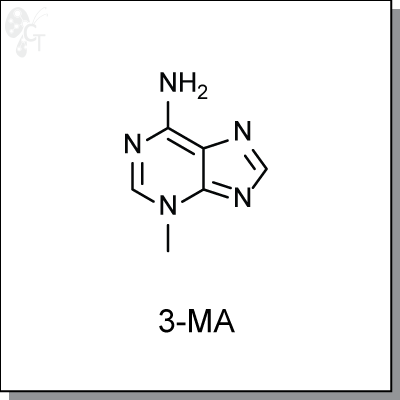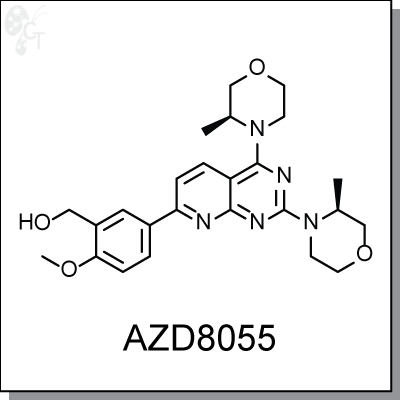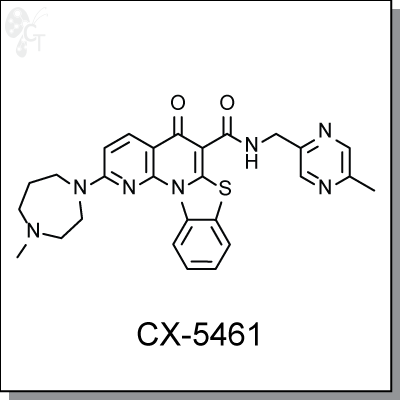Cellular Mechanism, Autophagy I
Product Name: 3-MA (#C0362)

3-methyladenine (3MA) is a specific inhibitor of autophagy with activity against Vps34 and PI3Kg at IC50
values of 25 and 60 uM, respectively. [1] At concentrations of 5 mM, 3-methyladenine inhibits protein
degradation in isolated rat hepatocytes by about 60% without any adverse effects on exogenous protein,
protein synthesis, or intracellular ATP levels. [2]
3-methyladenine was shown in time-dependent studies to inhibit class I and class III PI3K in different
manners when compared to wortmannin. [3] In an inflammation model setting, 3-methyladenine was found
to enhance LPS-induced NF-kB activation and production of TNF-a, iNOS, COX-2, IL-1b, and IL-12. Through
the inhibition of Akt by way of class I PI3K interference, 3-methyladenine can positively regulate p38, JNK,
and p65, while negatively regulate TBK1 and IFN regulatory factor 3. [4]
|
Details
|
Chemical Formula:
|
|
C6H7N5
|
|
CAS No.:
|
|
5142-23-4
|
|
Molecular weight:
|
|
149.5
|
|
Purity:
|
|
> 98%
|
|
Appearance:
|
|
White
|
|
Chemical name:
|
|
3-methyladenine
|
|
Solubility:
|
|
Up to 22 mM in DMSO
|
|
Synonyms:
|
|
3-MA, 3-Methyl-3H-purin-6-amine, 3-Methyl-3H-adenine
|
|
Storage:
|
|
For longer shelf life, store solid powder at 4oC desiccated, or store DMSO solution
at -20oC.
|
1. Miller et al., Finding a fitting shoe for Cinderella: searching for an autophagy inhibitor. Autophagy, 2010, 6
(6), 805-807. Pubmed ID: 20574157
2. Seglen et al., 3-Methyladenine: specific inhibitor of autophagic/lysosomal protein degradation in isolated
rat hepatocytes. Proc. Natl. Acad. Sci. 1982, 79(6), 1889-1892. Pubmed ID: 6952238
3. Wu et al., Dual role of 3-methyladenine in modulation of autophagy via different temporal patterns of
inhibition on class I and III phosphoinositide 3-kinase. J. Biol. Chem. 2010, 285(14), 10850-10861.
Pubmed ID: 20123989
4. Lin et al., Regulation of inflammatory response by 3-methyladenine involves the coordinative actions on
Akt and glycogen synthase kinase 3? rather than autophagy. J. Immunol. 2012, 189, 4154-4164.
Pubmed ID: 6952238
|
Product Name: AZD8055 | mTOR inhibitor (#C2955)

AZD8055 is a potent and orally bioavailable ATP-competitive inhibitor of mTOR kinase with an IC50 of 0.8 nM.
It inhibits both mTORC1 and mTORC2. AZD8055 shows excellent selectivity (1,000-fold) against all class I
PI3K isoforms and other members of the PI3K-like kinase family. Furthermore, AZD8055 showed no
significant activity against a panel of 260 kinases at concentrations up to 10 µM [1].
The serine/threonine kinase mTOR is crucial for cell growth and proliferation. It regulates cap-dependent
translation through the mTORC1 complex and Akt activation through the mTORC2 complex. AZD8055 inhibits
the phosphorylation of mTORC1 substrates p70S6K and 4E-BP1 as well as the phosphorylation of the
mTORC2 substrate AKT. AZD8055 potently inhibits proliferation, induces autophagy and apoptosis in different
cells. In vivo, AZD8055 induces a dose-dependent pharmacodynamic effect on phosphorylated S6 and
phosphorylated AKT and results in significant tumor growth inhibition and/or regression in xenografts
representing a broad range of tumor types [1-4].
|
Details
|
Chemical Formula:
|
|
C25H31N5O4
|
|
CAS No.:
|
|
1009298-09-2
|
|
Molecular weight:
|
|
465.54
|
|
Purity:
|
|
> 98%
|
|
Appearance:
|
|
white
|
|
Chemical name:
|
|
(5-(2,4-bis((S)-3-methylmorpholino)pyrido[2,3-d]pyrimidin-7-yl)-2-
methoxyphenyl)methanol
|
|
Solubility:
|
|
Up to 22 mM in DMSO
|
|
Synonyms:
|
|
AZD8055, AZD-8055
|
|
Storage:
|
|
For longer shelf life, store solid powder at 4oC desiccated, or store DMSO solution
at -20oC.
|
References
1. Chresta CM, et al. AZD8055 is a potent, selective, and orally bioavailable ATP-competitive mammalian
target of rapamycin kinase inhibitor with in vitro and in vivo antitumor activity. Cancer Res. 2010. 70(1):
288-98. Pubmed ID: 20028854
2. Sini P, et al. Simultaneous inhibition of mTORC1 and mTORC2 by mTOR kinase inhibitor AZD8055 induces
autophagy and cell death in cancer cells. Autophagy. 2010. 6(4). Pubmed ID: 20364113
3. Willems L, et al. The dual mTORC1 and mTORC2 inhibitor AZD8055 has anti-tumor activity in acute
myeloid leukemia. . Leukemia. 2012. 26(6):1195-202. Pubmed ID: 22143671
4. Naing A,et al. Safety, tolerability, pharmacokinetics and pharmacodynamics of AZD8055 in advanced solid
tumours and lymphoma. Br J Cancer. 2012. 107(7):1093-9. Pubmed ID: 22935583
|
Product Name: CX-5461 | RNA Pol | inhibitor (#C2954)

CX-5461 is a potent, orally bioavailable small molecule inhibitor of rRNA synthesis in cancer cells. It
selectively inhibits rRNA synthesis by polymerase I (Pol I) in the nucleolus, but does not inhibit mRNA
synthesis by RNA Polymerase II (Pol II), DNA replication or protein synthesis. (In tested cell lines, IC50s for
Pol I range from 54nmol/L to 142nmol/L, IC50s for Pol II is higher than 25umol/L.)
CX-5461 exhibits a broad range of antiproliferative activity, with wild-type (wt) p53 cells derived from
hematological malignancies being the most sensitive. (p53 wt solid tumors: median IC50=164 nM; p53 wt
hematologic cancers cells: median IC50=25 nM). CX-5461 selectively kills cancer cells relative to normal
cells. (Median IC50 in normal cells is 5,000 nM.) CX-5461 directly targets the initiation stage of rRNA
synthesis, induces both autophagy and senescene, but not apoptosis in a p53-independent process in solid
tumor cell lines. In wt p53 hematologic cancer cells, however, inhibition of Pol I results in nucleolar stress
and release of ribosomal proteins (RP) from the nucleolus. The RP bind to Mdm2 and release p53 to cause
apoptosis in cancer cells. CX-5461 exhibits potent in vivo antitumor activity against both human solid tumor in
xenograft models, and leukemia and lymphoma in animal models [1-2].
|
Details
|
Chemical Formula:
|
|
C27H27N7O2S
|
|
CAS No.:
|
|
1138549-36-6
|
|
Molecular weight:
|
|
513.61
|
|
Purity:
|
|
> 98%
|
|
Appearance:
|
|
White
|
|
Chemical name:
|
|
5H-Benzothiazolo[3,2-a][1,8]naphthyridine-6-carboxamide, 2-(hexahydro-4-
methyl-1H-1,4-diazepin-1-yl)-N-[(5-methyl-2-pyrazinyl)methyl]-5-oxo-
|
|
Solubility:
|
|
Up to 1 mM in DMSO
|
|
Synonyms:
|
|
CX-5461, CX5461
|
|
Storage:
|
|
For longer shelf life, store solid powder at 4oC desiccated, or store DMSO solution
at -20oC.
|
References
1. Drygin D., et al. Targeting RNA polymerase I with an oral small molecule CX-5461 inhibits ribosomal RNA
synthesis and solid tumor growth. Cancer Res. 2011. 71(4):1418-30. Pubmed ID: 21159662
2. Bywater MJ., et al. Inhibition of RNA polymerase I as a therapeutic strategy to promote cancer-specific
activation of p53. Cancer Cell. 2012. 22(1):51-65. Pubmed ID: 22789538
|
|


